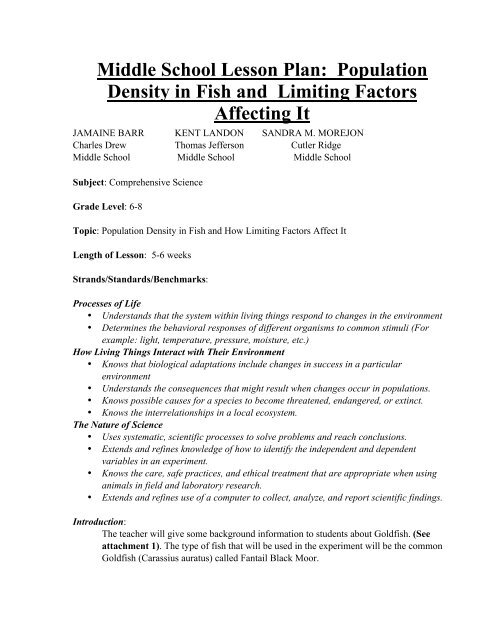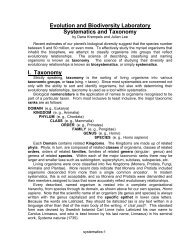Middle School Lesson Plan: Population Density in Fish and Limiting ...
Middle School Lesson Plan: Population Density in Fish and Limiting ...
Middle School Lesson Plan: Population Density in Fish and Limiting ...
Create successful ePaper yourself
Turn your PDF publications into a flip-book with our unique Google optimized e-Paper software.
<strong>Middle</strong> <strong>School</strong> <strong>Lesson</strong> <strong>Plan</strong>: <strong>Population</strong><br />
<strong>Density</strong> <strong>in</strong> <strong>Fish</strong> <strong>and</strong> Limit<strong>in</strong>g Factors<br />
Affect<strong>in</strong>g It<br />
JAMAINE BARR KENT LANDON SANDRA M. MOREJON<br />
Charles Drew Thomas Jefferson Cutler Ridge<br />
<strong>Middle</strong> <strong>School</strong> <strong>Middle</strong> <strong>School</strong> <strong>Middle</strong> <strong>School</strong><br />
Subject: Comprehensive Science<br />
Grade Level: 6-8<br />
Topic: <strong>Population</strong> <strong>Density</strong> <strong>in</strong> <strong>Fish</strong> <strong>and</strong> How Limit<strong>in</strong>g Factors Affect It<br />
Length of <strong>Lesson</strong>: 5-6 weeks<br />
Str<strong>and</strong>s/St<strong>and</strong>ards/Benchmarks:<br />
Processes of Life<br />
• Underst<strong>and</strong>s that the system with<strong>in</strong> liv<strong>in</strong>g th<strong>in</strong>gs respond to changes <strong>in</strong> the environment<br />
• Determ<strong>in</strong>es the behavioral responses of different organisms to common stimuli (For<br />
example: light, temperature, pressure, moisture, etc.)<br />
How Liv<strong>in</strong>g Th<strong>in</strong>gs Interact with Their Environment<br />
• Knows that biological adaptations <strong>in</strong>clude changes <strong>in</strong> success <strong>in</strong> a particular<br />
environment<br />
• Underst<strong>and</strong>s the consequences that might result when changes occur <strong>in</strong> populations.<br />
• Knows possible causes for a species to become threatened, endangered, or ext<strong>in</strong>ct.<br />
• Knows the <strong>in</strong>terrelationships <strong>in</strong> a local ecosystem.<br />
The Nature of Science<br />
• Uses systematic, scientific processes to solve problems <strong>and</strong> reach conclusions.<br />
• Extends <strong>and</strong> ref<strong>in</strong>es knowledge of how to identify the <strong>in</strong>dependent <strong>and</strong> dependent<br />
variables <strong>in</strong> an experiment.<br />
• Knows the care, safe practices, <strong>and</strong> ethical treatment that are appropriate when us<strong>in</strong>g<br />
animals <strong>in</strong> field <strong>and</strong> laboratory research.<br />
• Extends <strong>and</strong> ref<strong>in</strong>es use of a computer to collect, analyze, <strong>and</strong> report scientific f<strong>in</strong>d<strong>in</strong>gs.<br />
Introduction:<br />
The teacher will give some background <strong>in</strong>formation to students about Goldfish. (See<br />
attachment 1). The type of fish that will be used <strong>in</strong> the experiment will be the common<br />
Goldfish (Carassius auratus) called Fantail Black Moor.
Background <strong>in</strong>formation:<br />
The Goldfish hatches with<strong>in</strong> 3-4 days. By the end of the first day the eggs are a color tan<br />
to yellow <strong>and</strong> some are color white. The ones that are most fertile are clear. The other<br />
ones are not fertile <strong>and</strong> will most likely get fungus. Once fungus appears it should be<br />
removed immediately so that the fungus will not spread to other fish. There are some<br />
breeders that will add methylene to help reduce the occurrence of fungus. The fish will<br />
hatch from the back part, show<strong>in</strong>g its tail first then us<strong>in</strong>g it will release its head. At birth,<br />
the Goldfish is about 1/16 th to 1/8 th of an <strong>in</strong>ch <strong>and</strong> has two black eyes, a long notochord<br />
<strong>and</strong> a full yolk sac. If a fish falls to the bottom, there is no problem. After 48 hours a<br />
fish starts to absorb their yolk sac <strong>and</strong> an air bladder <strong>and</strong> a f<strong>in</strong> will become noticeable.<br />
After this time they will also start to fill their air bladders which will help the fish to start<br />
swimm<strong>in</strong>g <strong>and</strong> seek<strong>in</strong>g food. They will eat anyth<strong>in</strong>g they can put <strong>in</strong> their mouths <strong>and</strong> that<br />
is why it is important to have food <strong>in</strong> your h<strong>and</strong>.<br />
The Goldfish will mature <strong>in</strong> about 1 year <strong>and</strong> are at their prime dur<strong>in</strong>g their 3 rd year. A<br />
male will mature when his tubercles appear on the pectoral f<strong>in</strong>s <strong>and</strong> gill covers. This<br />
does not always occur, however, but can also be seen <strong>in</strong> females. Goldfish can live to be<br />
over 10 years old.<br />
The Goldfish need a diet high <strong>in</strong> carbohydrates which they can obta<strong>in</strong> by eat<strong>in</strong>g tetramis<br />
flake food, dried shrimp, live mealworms or any variety of these foods <strong>in</strong> pellet form.<br />
These fish should be fed once daily. They are not picky eaters.<br />
There are some tox<strong>in</strong>s to be aware of <strong>in</strong> the tank. Whether eaten or not, the processes can<br />
make food <strong>in</strong>to ammonia. In turn, it can become toxic <strong>and</strong> turn <strong>in</strong>to equally toxic nitrate.<br />
There are also other factors to watch out for.<br />
Hypothesis:<br />
In this experiment the student will be test the mortality rate of Goldfish due to limit<strong>in</strong>g<br />
factors.<br />
Instructional Objectives:<br />
Students will collect data over a period of 5-6 weeks for the experiment of <strong>Population</strong><br />
<strong>Density</strong> of <strong>Fish</strong> <strong>and</strong> How Limit<strong>in</strong>g Factors Affect It.<br />
Students will graph data results <strong>and</strong> write discussion on results.<br />
Materials:<br />
- 3 10-gallon tanks<br />
- Set up materials for tanks. Example: <strong>Plan</strong>ts, background.<br />
- Goldfish<br />
- <strong>Fish</strong> food<br />
- Thermometer<br />
- pH tester<br />
- Ammonia tester<br />
- Fresh water for tanks
Methods:<br />
Set Up of Experiment:<br />
Data: Data will be shared by class <strong>and</strong> by schools. Data will be compared <strong>and</strong> results<br />
will be presented us<strong>in</strong>g graphs <strong>and</strong> charts <strong>in</strong> different colors us<strong>in</strong>g Microsoft Excel.<br />
Variables: The variable will be the amount of fish liv<strong>in</strong>g with<strong>in</strong> a set volume.<br />
Constants: The constants <strong>in</strong> the experiment will be the food, the time the food is given,<br />
light, temperature, volume of water, <strong>and</strong> <strong>in</strong>itials pH levels.<br />
Procedure:<br />
1. Obta<strong>in</strong> 2 10-gallon fish tanks. Add a carbon filter to each tank.<br />
2. Add 5 gallons of fresh water to the tanks.<br />
3. Label tanks #1,#2, <strong>and</strong> #3.<br />
4. To tank # 1, add 5 fish to it.<br />
5. To tank #2 add 10 fish to it.<br />
6. To tank # 3, add 15 fish to it.<br />
7. Students (work<strong>in</strong>g <strong>in</strong> groups of 5) will monitor temperature us<strong>in</strong>g a thermometer.<br />
Students will record this every 2 days.<br />
8. Students are to give each tank the same amount of food each day <strong>and</strong> at the same<br />
time dur<strong>in</strong>g the day.<br />
9. Students will monitor the pH to determ<strong>in</strong>e acidity or basicity. Students will keep<br />
a record of the pH levels daily.<br />
10.Use ammonia tester to check the levels of nitrates of ammonia <strong>and</strong> record results.<br />
11.Check to make sure fish are surviv<strong>in</strong>g <strong>and</strong> record any fatalities over the 6 weeks<br />
periods.
Group Name: ________________________<br />
Tank # 1<br />
Week 1<br />
Measurements Monday Tuesday Wed. Thursday Friday<br />
Number of <strong>Fish</strong><br />
pH Level<br />
Ammonia<br />
Temperature<br />
Week 2<br />
Measurements Monday Tuesday Wed. Thursday Friday<br />
Number of <strong>Fish</strong><br />
pH Level<br />
Ammonia<br />
Temperature<br />
Week 3<br />
Measurements Monday Tuesday Wed. Thursday Friday<br />
Number of <strong>Fish</strong><br />
pH Level<br />
Ammonia<br />
Temperature<br />
Week 4<br />
Measurements Monday Tuesday Wed. Thursday Friday<br />
Number of <strong>Fish</strong><br />
pH Level<br />
Ammonia<br />
Temperature<br />
Week 5<br />
Measurements Monday Tuesday Wed. Thursday Friday<br />
Number of <strong>Fish</strong><br />
pH Level<br />
Ammonia<br />
Temperature<br />
Week 6<br />
Measurements Monday Tuesday Wed. Thursday Friday<br />
Number of <strong>Fish</strong><br />
pH Level<br />
Ammonia<br />
Temperature<br />
For Tank # 2 <strong>and</strong> #3, there will be same tables as above.
Sample Charts made with Microsoft Excel:<br />
Mortality Rate of Goldfish for Tank # 1<br />
3<br />
2.5<br />
2<br />
1.5<br />
1<br />
0.5<br />
0<br />
Mon. Tue s. Wed. Thur s. Fri.<br />
Week 1<br />
Week 2<br />
Week 3<br />
Days of the Week<br />
Attachment 1<br />
The Common Goldfish is a type of carp. These hardy fish have been kept <strong>in</strong> ponds<br />
<strong>and</strong> aquariums for centuries <strong>in</strong> Asia. They have a life span of about 10 years. When<br />
Goldfish return to the wild, they revert to their natural colors (green to black) <strong>in</strong> just a<br />
few generations.<br />
If kept <strong>in</strong> an aquarium, a 2-<strong>in</strong>ch long Goldfish should have at least 2 gallons of water.<br />
In general, at least one gallon for each <strong>in</strong>ch of fish is necessary or the Goldfish will<br />
become stunted <strong>and</strong> will have a shorter lifespan.<br />
Anatomy: This brightly-colored fish has orange scales. The average Goldfish grows<br />
to be about 3 to 5 <strong>in</strong>ches (8 to 13 cm) long. The largest Goldfish are roughly 10 <strong>in</strong>ches<br />
(25 cm) long.<br />
Diet: Like all carp, Goldfish eat t<strong>in</strong>y plants <strong>and</strong> animals found root<strong>in</strong>g <strong>in</strong> the mud on<br />
the pond floor.<br />
References:<br />
http://www.enchantedlearn<strong>in</strong>g.com/subjects/fish/pr<strong>in</strong>touts/Goldfishpr<strong>in</strong>tout.shtml

















